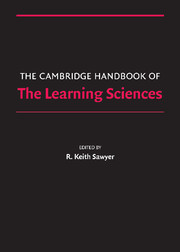Book contents
- Frontmatter
- Contents
- Preface
- Contributors
- 1 Introduction
- PART I FOUNDATIONS
- PART II METHODOLOGIES
- PART III THE NATURE OF KNOWLEDGE
- PART IV MAKING KNOWLEDGE VISIBLE
- 19 Project-Based Learning
- 20 Making Authentic Practices Accessible to Learners
- 21 BioKIDS
- 22 Cultivating Model-Based Reasoning in Science Education
- 23 Exploring Mathematics Through Construction and Collaboration
- PART V LEARNING TOGETHER
- PART VI LEARNING ENVIRONMENTS
- Afterword: After How Comes What
- Epilogue: The Fundamental Issue in the Learning Sciences
- Author Index
- Subject Index
- References
19 - Project-Based Learning
Published online by Cambridge University Press: 05 June 2012
- Frontmatter
- Contents
- Preface
- Contributors
- 1 Introduction
- PART I FOUNDATIONS
- PART II METHODOLOGIES
- PART III THE NATURE OF KNOWLEDGE
- PART IV MAKING KNOWLEDGE VISIBLE
- 19 Project-Based Learning
- 20 Making Authentic Practices Accessible to Learners
- 21 BioKIDS
- 22 Cultivating Model-Based Reasoning in Science Education
- 23 Exploring Mathematics Through Construction and Collaboration
- PART V LEARNING TOGETHER
- PART VI LEARNING ENVIRONMENTS
- Afterword: After How Comes What
- Epilogue: The Fundamental Issue in the Learning Sciences
- Author Index
- Subject Index
- References
Summary
Any teacher or parent can tell you that many students are bored in school. But many of them tend to assume that boredom is not a problem with the best students, and that if students tried harder or learned better they wouldn't be bored. In the 1980s and 1990s, education researchers increasingly realized that when students are bored and unengaged, they are less likely to learn (Blumenfeld et al., 1991). Studies of student experience found that almost all students are bored in school, even the ones who score well on standardized tests (Csikszentmihalyi, Rathunde, & Whalen, 1993). By about 1990, it became obvious to education researchers that the problem wasn't the fault of the students; there was something wrong with the structure of schooling. If we could find a way to engage students in their learning, to restructure the classroom so that students would be motivated to learn, that would be a dramatic change.
Also by about 1990, new assessments of college students had shown that the knowledge they acquired in high school remained at a superficial level. Even the best-scoring students, those at the top colleges, often had not acquired a deeper conceptual understanding of material – whether in science, literature, or math (Gardner, 1991). Educators still face these critical problems today.
- Type
- Chapter
- Information
- The Cambridge Handbook of the Learning Sciences , pp. 317 - 334Publisher: Cambridge University PressPrint publication year: 2005
References
- 127
- Cited by



